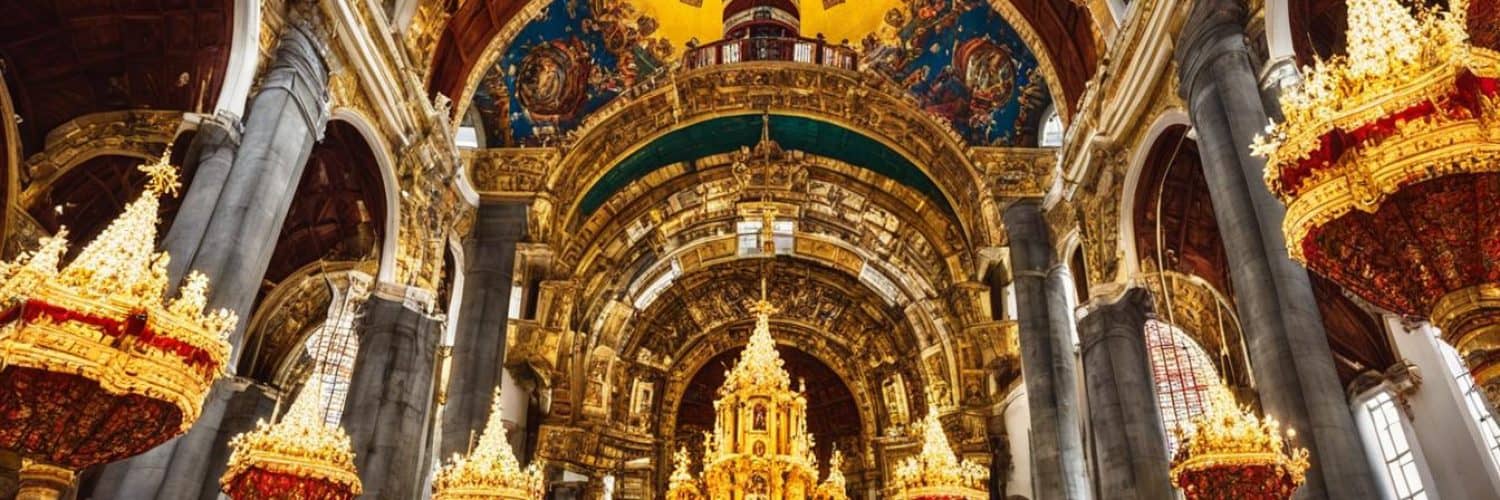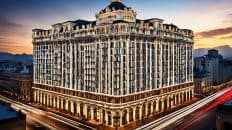Welcome to Basilica del Santo Niño, a historical landmark and religious pilgrimage site in Cebu, Philippines. This iconic basilica showcases magnificent Spanish colonial architecture and holds great significance in Catholic heritage. It is not only a cultural icon but also a symbol of devotion and faith for many.
As one of the oldest churches in the country, Basilica del Santo Niño attracts tourists and pilgrims from all over the world, making it a popular destination for religious tourism. The rich history and spiritual atmosphere of the basilica offer a unique and meaningful experience for visitors.
Key Takeaways:
- Basilica del Santo Niño is a historical landmark and religious pilgrimage site in Cebu, Philippines.
- The basilica showcases stunning Spanish colonial architecture and holds great significance in Catholic heritage.
- It is a cultural icon and a symbol of devotion and faith for many.
- Basilica del Santo Niño attracts tourists and pilgrims from all over the world, making it a popular destination for religious tourism.
- Visiting the basilica offers a unique and spiritually enriching experience for travelers.
History of Basilica del Santo Niño
The Basilica del Santo Niño in Cebu, Philippines has a fascinating history that dates back to the Spanish colonial period. It was established in 1565 by King Philip II of Spain, marking a significant milestone in the spread of Christianity in the Philippines. The basilica holds religious artifacts of great importance, including a Flemish statuette of the Christ child (Santo Niño) believed to have been gifted by the explorer Ferdinand Magellan.
The image of the Santo Niño has deep roots in devotion and holds a special place in the hearts of many Filipinos. It is believed to possess miraculous powers and has been revered for centuries. Despite facing multiple fires throughout its history, the Santo Niño image has endured and continues to inspire faith and devotion among its followers.
“The Santo Niño image is a testament to the enduring faith of the Filipino people. Its survival through the fires is seen as a symbol of resilience and divine protection.”
The image of the Santo Niño was discovered in a burned wooden box, which adds to its significance and the devotion it evokes. The burnt box is a tangible reminder of the challenges and trials the image has faced, further strengthening the belief in its miraculous nature. Today, the Basilica del Santo Niño stands as a testament to the enduring faith and the rich religious heritage of the Philippines.
Architecture and Design of Basilica del Santo Niño
The Basilica del Santo Niño in Cebu, Philippines boasts a stunning baroque structure that showcases intricate architectural details. The combination of ornate design elements and the use of exquisite materials make this basilica a true masterpiece of Spanish colonial architecture.
The beautifully crafted facade of the basilica immediately catches the eye of visitors, with its elaborate carvings and decorative motifs. The facade is adorned with intricate sculptures and reliefs, depicting scenes from Catholic history and Filipino culture. It serves as a visual representation of the religious devotion and cultural heritage encompassed by the basilica.
In addition to the facade, the belfry of the Basilica del Santo Niño is another noteworthy feature. Standing tall and commanding, the belfry is a testament to the architectural ingenuity of the time. It offers a panoramic view of the surrounding area, allowing visitors to appreciate the beauty of Cebu and the rich history that surrounds the basilica.
“The baroque architecture of the Basilica del Santo Niño is a sight to behold. The fine craftsmanship and attention to detail truly capture the essence of the Spanish influence in the Philippines.”
In 2013, the basilica faced a devastating earthquake that caused significant damage to its facade and belfry. However, through meticulous restoration efforts, the basilica has been able to recover and regain its original grandeur. The restoration process involved skilled craftsmen and experts who carefully reconstructed the damaged areas, ensuring that the basilica retained its historical and architectural integrity.
Captivating Architecture of Basilica del Santo Niño
| Features | Description |
|---|---|
| Baroque Structure | The basilica showcases the opulence and grandeur of the baroque architectural style, known for its dramatic flair and intricate embellishments. |
| Facade | The facade of the basilica features elaborately carved sculptures and reliefs, depicting religious and cultural scenes that highlight the rich heritage of the Philippines. |
| Belfry | The belfry stands as a prominent feature of the basilica, offering a panoramic view of the surrounding area and serving as a reminder of the basilica’s historical significance. |
| Restoration | Following the 2013 earthquake, the damaged facade and belfry underwent extensive restoration to bring them back to their original splendor, ensuring the preservation of the basilica’s architectural beauty. |
Significance of Santo Niño Image
The Santo Niño image housed in Basilica del Santo Niño is of great significance to both locals and visitors. It is a revered object of veneration and is believed to possess miraculous powers. The Santo Niño image holds a special place in the hearts of the people, inspiring devotion and deepening their faith.
“The Santo Niño image is a symbol of hope and strength. It serves as a constant reminder of God’s grace and love in our lives.” – Devotee testimonial
Every year, the Santo Niño image takes center stage in Cebu’s largest annual event, the Sinulog Festival. This vibrant and colorful festival brings together people from all walks of life to celebrate and honor the Santo Niño. The Sinulog Festival is a jubilant expression of devotion, featuring lively street parades, traditional dances, and vibrant performances.
The Sinulog Festival is a time of joy and celebration, where the rich cultural heritage of Cebu and the deep spiritual significance of the Santo Niño image are showcased. The festival is not only a religious event but also a cultural extravaganza that highlights the unity and diversity of the Filipino people.
“The Sinulog Festival is a magical experience that brings people together in celebration of our faith and cultural heritage. It is a time of renewal, inspiration, and thanksgiving.” – Festival participant
Throughout the festival, the streets come alive with vibrant costumes, the beat of drums, and the rhythm of native gongs. It is a time filled with devotion, joy, and a sense of community as people come together to honor the Santo Niño and express their gratitude for blessings received.
The Sinulog Festival and the veneration of the Santo Niño image in Basilica del Santo Niño are powerful expressions of faith, culture, and tradition. They serve as a testament to the enduring legacy of devotion and the deep spiritual connection that the people of Cebu share with the miraculous Santo Niño image.
Programs and Activities at Basilica del Santo Niño
Basilica del Santo Niño is not just a place of worship, but also a hub of community engagement and support. The church offers a variety of programs and activities that cater to the spiritual and social needs of the people.
Daily Eucharist, Prayers, and Novena
At Basilica del Santo Niño, there are daily Eucharistic celebrations where visitors can participate in the sacred ritual of communion. The church also provides a peaceful environment for personal prayers and reflection. Additionally, the Novena—a series of prayers conducted over nine consecutive days—is a significant spiritual practice observed by many devotees.
Children’s Welfare Foundation
The Children’s Welfare Foundation, a charitable initiative led by Basilica del Santo Niño, focuses on improving the lives of underprivileged children. The foundation provides educational support, healthcare services, and other essential resources to ensure a brighter future for these children.
Sunday Feeding Program – Kan-anan ni Niño
As a testament to its commitment to serving others, the church organizes the Sunday Feeding Program, locally known as “Kan-anan ni Niño.” This program aims to alleviate hunger and malnutrition by providing nutritious meals to children and families in need.
| Program/Initiative | Description |
|---|---|
| Kinatarcan Island Apostolate | A community outreach program that supports the residents of Kinatarcan Island by providing educational assistance, livelihood opportunities, and healthcare services. |
| Balay Bao Housing project | A housing project that aims to provide safe and sustainable homes for families who are living in poor conditions or are displaced due to natural disasters. |
| Monthly Blood Donation | Basilica del Santo Niño conducts regular blood donation drives to support local hospitals and ensure a steady supply of blood for medical emergencies. |
Promoting Love and Compassion
These programs and activities organized by Basilica del Santo Niño reflect the church’s dedication to promoting love, compassion, and social justice. By extending its reach beyond the traditional religious practices, the church serves as a catalyst for positive change in the community.
“The best way to find yourself is to lose yourself in the service of others.” – Mahatma Gandhi
Participating in these programs not only allows individuals to deepen their faith but also enables them to contribute to the betterment of society. Through acts of kindness and generosity, Basilica del Santo Niño continues to inspire and bring hope to the lives of many.
Historical Notes and Testimonies
Basilica del Santo Niño in Cebu, Philippines has a rich collection of historical notes and testimonies that offer valuable insights into the church’s profound history and spiritual significance. These historical chronicles provide a glimpse into the past, allowing visitors to connect with the deep-rooted traditions and devotion associated with the Santo Niño image.
The testimonies of miracles attributed to the Santo Niño inspire spiritual growth and serve as a testament to the unwavering faith of the devotees. These miraculous occurrences have been documented and shared over the years, creating a sense of awe and wonder among believers and visitors alike.
“The stories of miraculous healings and answered prayers have been passed down through generations. They are a source of inspiration and a reminder of the power of faith,” says Father Miguel, a priest at the basilica.
Visitors to Basilica del Santo Niño are encouraged to explore the historical notes and testimonies, deepening their understanding of the church’s significance and the remarkable stories associated with it. These accounts provide a unique perspective on the spiritual journey and serve as a source of inspiration for those seeking a deeper connection with their faith.
Testimonies of Miracles
One of the notable miracle testimonies is the story of a young child who was suffering from a severe illness. The child’s family prayed fervently to the Santo Niño for healing, and miraculously, the child made a full recovery. This testimony of divine intervention has become a source of hope for many who face challenging circumstances.
Another miraculous account involves a devotee who had lost all hope in finding a job. After praying to the Santo Niño for guidance and assistance, the devotee received a job offer that exceeded their expectations. This testimony of answered prayers has inspired countless individuals to seek solace and support in their own spiritual journeys.
Through these historical notes and miracle testimonies, Basilica del Santo Niño offers visitors a profound experience of spiritual growth and inspiration. The stories encapsulate the unwavering faith and devotion of the Filipino people, creating a sense of wonder and awe that continues to resonate with visitors from all walks of life.
Discover the compelling historical chronicles and miraculous testimonies at Basilica del Santo Niño, and be inspired by the faith and devotion that have shaped the spiritual landscape of Cebu, Philippines.
Location and Directions to Basilica del Santo Niño
Basilica del Santo Niño is conveniently situated along Osmeña Boulevard in the heart of Cebu City, Philippines. Its central location makes it easily accessible to both locals and tourists seeking to explore this historic religious site.
Whether you’re traveling by car, public transportation, or on foot, getting to the Basilica is a breeze. The bustling Osmeña Boulevard is a major thoroughfare that connects various parts of Cebu City, ensuring convenient access to the Basilica.
If you’re relying on public transportation, there are plenty of options available. Taxis, jeepneys, and tricycles are readily available modes of transport that can take you directly to the Basilica. Many locals and visitors also prefer to hire a motorbike or rent a car to navigate the city and reach the Basilica at their own pace.
For those who prefer guided tours or assistance with directions, Filipino Travel Experts can provide valuable information and guidance on how to reach the Basilica del Santo Niño. These local travel experts are well-versed in the city’s transportation networks and can offer helpful tips to ensure a smooth and hassle-free journey to this important religious site.
Visitors can also utilize navigation apps and maps to find the best route to the Basilica. These digital tools can provide step-by-step directions and real-time updates, making it easier to navigate the city’s streets and find your way to the Basilica del Santo Niño.
Upon arrival at the Basilica, there are parking facilities available nearby for those who choose to drive. Just a short walk from the Basilica’s entrance, visitors will be greeted by the majestic facade of this renowned religious site.
Experience the awe-inspiring beauty and spiritual significance of Basilica del Santo Niño by following the simple directions and guidance provided. Embark on a journey that combines history, faith, and cultural immersion in one remarkable destination.
Features of Basilica del Santo Niño
Basilica del Santo Niño, located in Cebu, Philippines, is renowned for its unique architectural features that showcase a blend of various influences. The church’s architectural style combines elements of Muslim, Romanesque, and neo-classicism, creating a visually stunning masterpiece.
The exterior of the basilica retains its original stone texture, adding to its historical charm and authenticity. As visitors approach the basilica, they are greeted by the grandeur of its facade and the intricately designed bell tower that enhances its architectural magnificence.
Inside the basilica, visitors are captivated by the dome-like ceiling, which reflects the influence of Muslim architecture. The intricate details and craftsmanship of the ceiling create a sense of awe and reverence, adding to the overall spiritual experience.
The basilica is not only a place of worship but also a repository of historical artifacts and religious significance. It houses a museum that showcases a collection of artifacts related to Christianity in Cebu, allowing visitors to delve deeper into the region’s religious and cultural heritage.
Moreover, Basilica del Santo Niño holds the prestigious distinction of being designated as a Basilica Minore by Pope Paul VI. This designation highlights the basilica’s importance and significance as a spiritual destination for Catholics around the world.
Festivals and Celebrations at Basilica del Santo Niño
Basilica del Santo Niño is widely recognized for its exuberant festivals and vibrant celebrations, with the Sinulog Festival taking the spotlight. This annual event, held every third Sunday of January, serves as a grand celebration that not only commemorates the Filipino’s triumph over their pagan past but also celebrates their acceptance of Christianity.
During the Sinulog Festival, the streets surrounding the Basilica del Santo Niño come alive with a mesmerizing display of colors, music, and dance. The main highlight is the street parade, where participants from various towns and cities in Cebu and other Philippine islands converge to showcase their rich cultural heritage.
“The Sinulog Festival offers a feast for the senses. As the participants don their elaborate and vibrant costumes, adorned with intricate details and symbolic patterns, they move to the rhythmic beat of drums and native gongs, creating an atmosphere of pure joy and infectious energy.”
Amidst the pulsating rhythms, the Sinulog Festival serves as a powerful testament to the deep-rooted traditions and religious fervor of the Filipino people. The festival not only celebrates their devotion to the Santo Niño but also provides a platform for cultural exchange and unity.
Through this colorful celebration, Basilica del Santo Niño strengthens its position as a beacon of faith, cultural heritage, and celebration, inviting visitors from around the world to partake in this remarkable event.
Attractions Nearby Basilica del Santo Niño
While visiting the Basilica del Santo Niño in Cebu, Philippines, make sure to explore the nearby attractions that offer a glimpse into the rich history and culture of the city. These attractions include:
Magellan’s Cross
Located in close proximity to the basilica, Magellan’s Cross is a historical landmark that signifies the arrival of Christianity in the Philippines. It is a must-visit site for history enthusiasts and offers insight into the country’s colonial past.
D. Jakosalem Street
D. Jakosalem Street is a bustling thoroughfare that showcases the vibrant atmosphere of Cebu. Along this street, you will find various shops, restaurants, and local establishments that offer a taste of the city’s vibrant culture and culinary delights.
Osmena Boulevard
Osmena Boulevard is a major road in Cebu City that stretches along the coast. It is lined with commercial establishments, hotels, and restaurants, making it a popular spot for both locals and tourists alike. Take a leisurely stroll along the boulevard and enjoy the stunning views of the ocean.
P. Burgos Street
P. Burgos Street is another vibrant street in Cebu City that offers a mix of modern establishments and historic sites. This street is home to many restaurants, bars, and entertainment venues, making it a great place to unwind and experience Cebu’s nightlife.
Plaza Sugbo
Located near the basilica, Plaza Sugbo is a historical park that showcases Cebu’s rich heritage. It features statues, monuments, and green spaces where you can relax and appreciate the city’s history and beauty.
These attractions near Basilica del Santo Niño add to the overall experience of exploring Cebu, allowing visitors to immerse themselves in the vibrant atmosphere and cultural heritage of the city.
Conclusion
When it comes to religious significance and cultural heritage, the Basilica del Santo Niño in Cebu, Philippines is a must-visit destination. This spiritual haven offers a deep immersion into the region’s rich history and traditions. From its stunning architecture to its vibrant festivals, the basilica provides a unique and spiritually enriching experience for travelers.
Whether you’re seeking religious devotion or cultural immersion, the Basilica del Santo Niño has something for everyone. Its historical significance as a Spanish colonial landmark and its role as a symbol of Catholic heritage make it an essential stop on any travel itinerary. The basilica’s cultural and spiritual importance cannot be overstated, making it a top destination for those seeking a deeper understanding of the Philippines’ religious and cultural roots.
Visiting the Basilica del Santo Niño is not just a trip, but a transformative journey. It allows you to connect with the region’s past, experience its present, and be inspired by its profound spirituality. Whether you’re a traveler interested in history, architecture, or religious pilgrimage, this spiritual destination offers a truly unique and memorable experience. So, make sure to add the Basilica del Santo Niño to your list of must-visit places when you travel to Cebu.
FAQ
What is Basilica del Santo Niño?
Basilica del Santo Niño is a historical landmark and religious pilgrimage site located in Cebu, Philippines. It is a symbol of devotion and faith, showcasing stunning Spanish colonial architecture and holding great significance in Catholic heritage. It is also a popular destination for religious tourism.
When was Basilica del Santo Niño established?
Basilica del Santo Niño was established in 1565 by the Spanish explorer King Philip II during the Spanish colonial period in the Philippines.
What is the significance of the Santo Niño image?
The Santo Niño image housed in Basilica del Santo Niño is a revered Flemish statuette of the Christ child. It dates back to the time of Ferdinand Magellan and is believed to be miraculous. The image survived multiple fires and was found in a burned wooden box, adding to its significance and devotion.
What programs and activities are offered at Basilica del Santo Niño?
Basilica del Santo Niño offers various programs and activities, including daily Eucharist, prayers, and the Novena. The church is also involved in charitable initiatives such as the Children’s Welfare Foundation, Sunday Feeding Program, Kan-anan ni Niño, Kinatarcan Island Apostolate, Balay Bao Housing project, and Monthly Blood Donation.
Where is Basilica del Santo Niño located?
Basilica del Santo Niño is located along Osmeña Boulevard in Cebu City, Philippines.
What are the architectural features of Basilica del Santo Niño?
Basilica del Santo Niño features a stunning baroque structure with intricate details. While the facade and belfry were damaged by an earthquake in 2013, they have been restored. The architectural style of the basilica reflects the Spanish colonial influence in the Philippines and showcases the beauty of the baroque style.
What is the Sinulog Festival?
The Sinulog Festival is Cebu’s largest annual event held every third Sunday of January. It is a grand celebration honoring the Santo Niño image. The festival includes a street parade where participants from different towns and cities in Cebu and other Philippine islands dress in colorful costumes and dance to the beat of drums and native gongs.
What are some nearby attractions to Basilica del Santo Niño?
Some nearby attractions to Basilica del Santo Niño include Magellan’s Cross, D. Jakosalem Street, Osmena Boulevard, P. Burgos Street, and Plaza Sugbo. These offer a glimpse into the rich history and culture of Cebu City.











Add comment